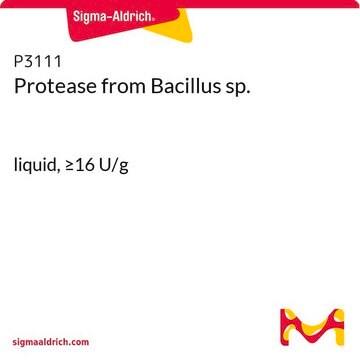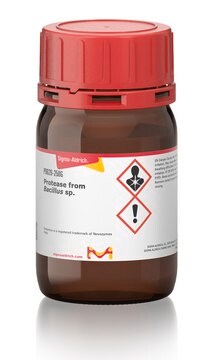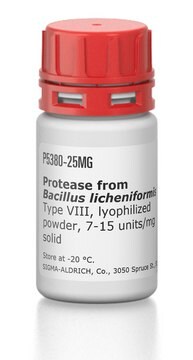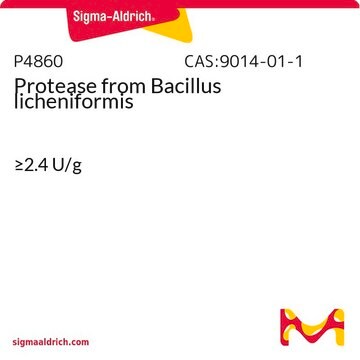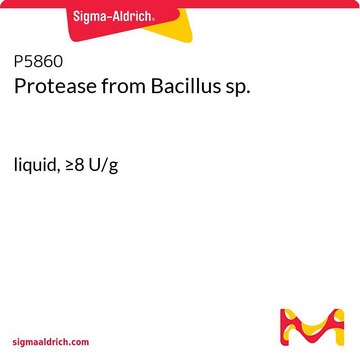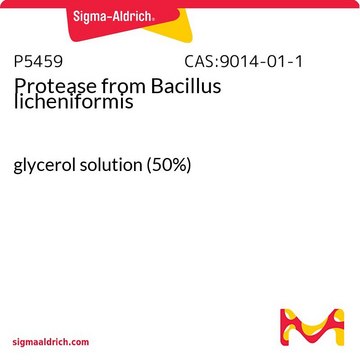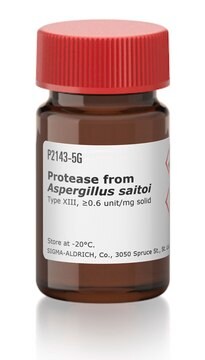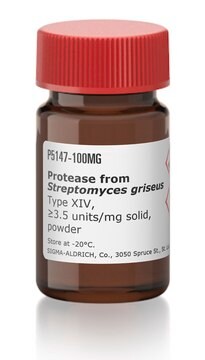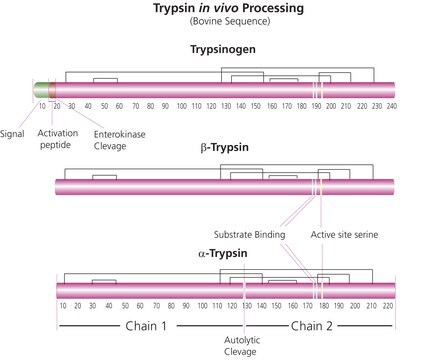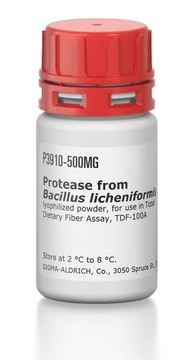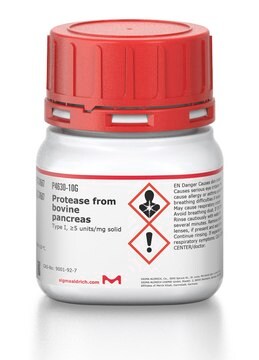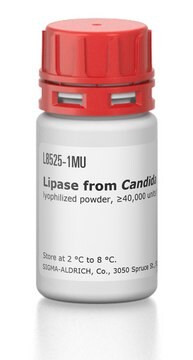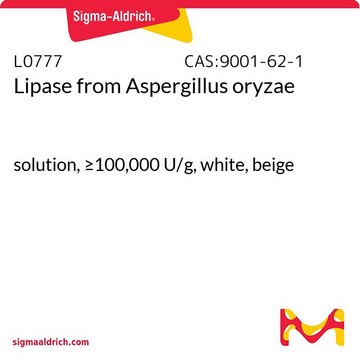P5985
Protease from Bacillus sp.
liquid, ≥16 U/g
Sinónimos:
Everlase 16.0 L
Iniciar sesiónpara Ver la Fijación de precios por contrato y de la organización
About This Item
Productos recomendados
biological source
Bacillus sp.
form
liquid
specific activity
≥16 U/g
mol wt
20--30 kDa
storage temp.
2-8°C
¿Está buscando productos similares? Visita Guía de comparación de productos
Categorías relacionadas
General description
Proteases are ubiquitously found in nature and microbes are the desired source for these enzymes. They are classified into four classes namely aspartic, serine, cysteine and metalloproteases.
Application
Protease from Bacillus sp. has been used to determine its proteolytic activity by spectrophotometric method.
Biochem/physiol Actions
Protease catabolizes proteins by hydrolysis of peptide bonds. Proteases are inactivated by serine active-site inhibitors, such as phenylmethylsulfonyl fluoride (PMSF) and diisopropylfluorophosphate. Proteases, secreted from Bacillus sp., typically have molecular weights ranging from 20,000 to 30,000. They are typically stabilized by Ca2+ and have high isoelectric points. It is highly soluble in detergents at a wide range of pH and temperatures. Protease improves healing process by efficiently removing necrotic materials from wounds. It is extensively used in laundry detergents to remove protein based stains from clothing. In addition, protease is also used in food, pharmaceutical, leather and silk industries. It is a key constituent in biopharmaceutical products including contact-lens enzyme cleaners and enzymatic deriders. Proteases also aid in various physiological processes such as protein turnover, digestion, blood coagulation, fertilization and cell differentiation. It also facilitates growth, cell signaling, the immune response, and apoptosis.
Legal Information
A product of Novozyme Corp.
signalword
Danger
hcodes
Hazard Classifications
Aquatic Chronic 3 - Eye Dam. 1 - Resp. Sens. 1
Storage Class
10 - Combustible liquids
wgk_germany
WGK 2
ppe
dust mask type N95 (US), Eyeshields, Faceshields, Gloves
Elija entre una de las versiones más recientes:
¿Ya tiene este producto?
Encuentre la documentación para los productos que ha comprado recientemente en la Biblioteca de documentos.
Los clientes también vieron
Irreversible inhibitors of serine, cysteine, and threonine proteases
Powers JC, et al.
Chemical Reviews, 102(12), 4639-4750 (2002)
Isolation, production and characterization of protease from Bacillus sp. isolated from soil sample
Josephine FS, et al.
Journal of Microbiology, 2(1), 163-168 (2012)
Laure El Chamy et al.
Nature immunology, 9(10), 1165-1170 (2008-08-30)
In drosophila, molecular determinants from fungi and Gram-positive bacteria are detected by circulating pattern-recognition receptors. Published findings suggest that such pattern-recognition receptors activate as-yet-unidentified serine-protease cascades that culminate in the cleavage of Spätzle, the endogenous Toll receptor ligand, and trigger
M Du et al.
Journal of animal science, 85(4), 919-927 (2006-12-21)
Mammalian target of rapamycin (mTOR) signaling is one of the main signaling pathways controlling protein synthesis. Leucine treatment upregulates mTOR signaling, which enhances protein synthesis; however, the mechanisms are not well understood. Herein, treatment of C2C12 myoblast cells with leucine
Effect of UV light on microbial proteases: From enzyme inactivation to antioxidant mitigation.
Lante A, et al.
Innovative Food Science & Emerging Technologies, 17, 130-134 (2013)
Nuestro equipo de científicos tiene experiencia en todas las áreas de investigación: Ciencias de la vida, Ciencia de los materiales, Síntesis química, Cromatografía, Analítica y muchas otras.
Póngase en contacto con el Servicio técnico